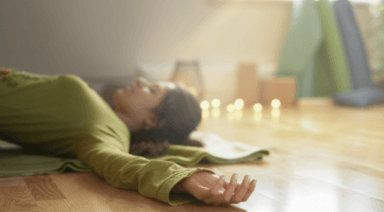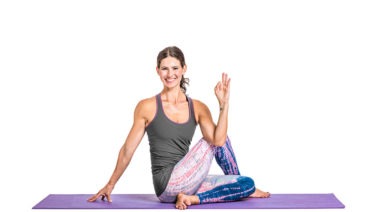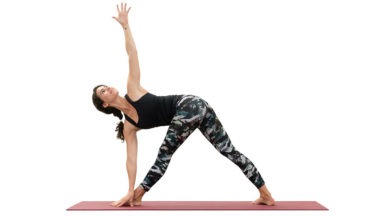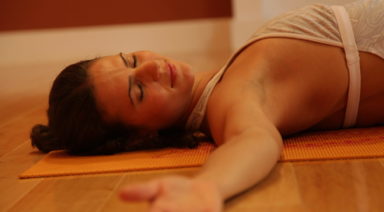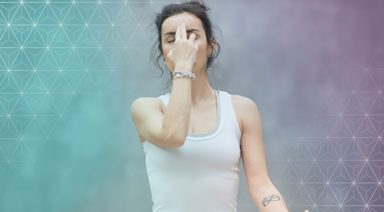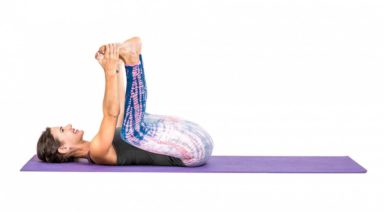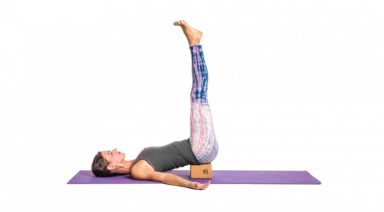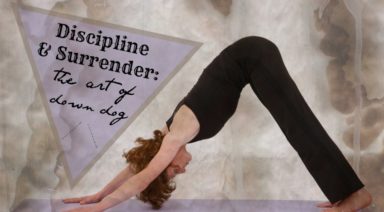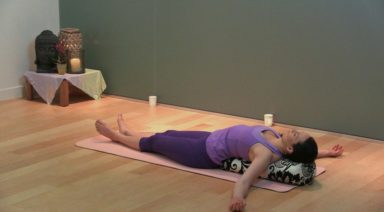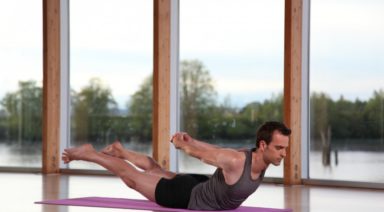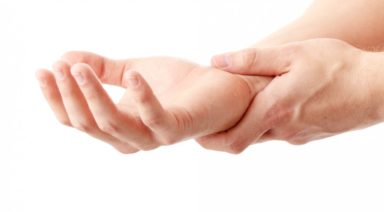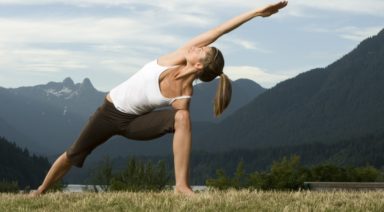Magic Map to Manifesting with Yoga Nidra
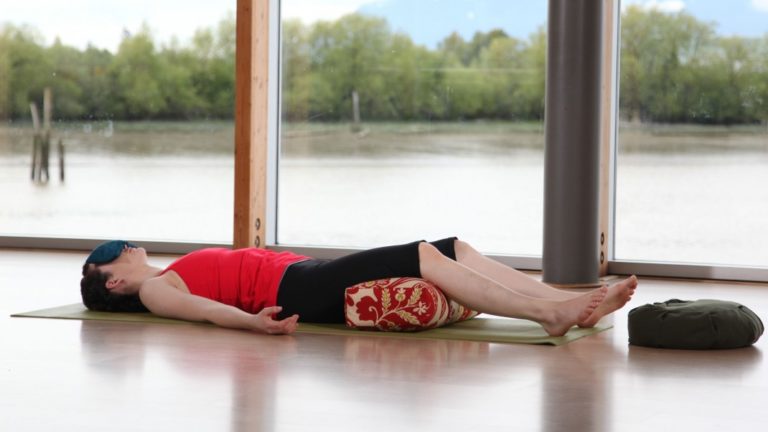
Are you working hard to create and manifest your ideal body, relationship and life of your dreams? What if I told you that there is a magic map for manifesting that is not only available for you to use anytime, but is also one of the most powerful and accessible forms of yoga. It is called yoga nidra. Chances are you’re interested; however, you may be thinking: “how come I haven’t heard about this before” or “what is this yoga nidra all about anyway?”
Maybe you’re already accustomed to manifesting and co-creating your reality, but this amazing manifesting tool still eludes you. Certainly, we have all heard about using positive affirmations, vision boards and setting intentions as practicable means for consciously manifesting money, love, health, abundance or whatever it is you want to bring into fruition. These are all great modalities, and I have personally used each of them in the past with some success, but the level of success that I’ve achieved through yoga nidra is unprecedented and incomparable to anything I have used before. I’m very results-driven and the practice of yoga nidra meditation definitely did not fall short of my expectations, in fact, it was quite the opposite experience.
Yoga nidra – which literally means yogic sleep – takes us beyond our limiting beliefs and conditionings, so that we can live a contented life that is free of conflict, anxiety, fear, dissatisfaction and suffering. During the practice of yoga nidra, we also work with sankalpa, and the resolves or intentions which are born from the heart. This is the stage of the practice where you set your sankalpa – your intention. Through sankalpa, anything that you want to work on or work with can be realized and resolved.
During the practice, we relax the body and mind enough to drop down into a lower brain wave pattern, such as Alpha or even Theta. This is where the manifesting magic happens.
Working with sankalpa is not only useful for clearing out old past wounds, but will also help you to manifest and create your future. My own life began to improve on so many levels after starting this practice. Not only did I lose thirty pounds, but I also emotionally improved my relationships.
I made a commitment to practicing yoga nidra every night before bed, and have done so for the last few years. It’s been said that all can fail you in life except for the resolve made during sankalpa — it’s really that powerful. I do all of my manifesting by setting my sankalpa during yoga nidra practice.
Yoga nidra works holistically on the level of our whole being, not just with our physical body, which also allows the practice to offer a broad range of healing benefits. Accordingly to yoga philosophy, we are more than just our physical bodies. We are multi-dimensional beings, made-up of many different interactive levels. These levels are referred to as sheaths or koshas. Like peeling the layer off an onion – starting from the outside and working your way into to the core – the koshas proceed from the outer to inner layer in greater levels of subtlety.
With this map we work from the outside-in — just like with the eight limbs or steps for practicing yoga.
We work from the outer most layer to the deepest inner knowing of who and what we are.
The First Five Koshas Explained:
1. Annamaya kosha
This is the physical body, and it is the most familiar aspect of our being. We start here by setting our intention. As we acknowledge our motivations we become aware of distractions, which otherwise might disturb our attention. Then we affirm our desire that no matter what, we remain attentive and motivated. This is the sheath of physical awareness; the physical body is welcomed into awareness as a vibrant and tactile sensation. Physical sensations are recognized as messengers – or pointers – to deeper underlying perceptions, and the body is realized to be an expanse of non-localized radiance.
2. Pranamaya kosha
This is the energy body, and it is your awareness of breath and energy. The breath is the most physical expression of prana – which is closely related to the breath. Here, your thought-created guidance system falls away, and physical well-being and joy start to arise. Every perception is recognized to be in perpetual motion; everything is constantly changing (parinâma).
3. Manamaya kosha
This is the mental-emotional body, and it manifests itself in our reliance on subtle thought (sarvichara). Often, we draw our attention to feeling imperfect (râga), rather than saying to ourselves: ‘I am perfect as I am’ (pûrñatvam-vairagya). Work to recognize your feelings and emotions as messengers. They are available to send us messages anytime we quiet and tune into them. Physical well-being, joy and equanimity are present now. The changing energy exposes the subtle world of feeling and emotions, which are comprised of polarities of opposites: warm versus cool, tense versus relaxed, joy versus sadness, fear versus courage. As opposites are received, they are recognized as messengers underlying unity and reveal profound levels of understanding.
4. Vijnanamaya kosha
This is the wisdom body and is otherwise known as the “sheath of intellect.” It is the fourth kosha and is considered part of the subtle body. Vijnana means knowing, and this sheath denotes the higher mind — the faculty of wisdom which lies underneath the processing, thinking and reactive mind. The revelation of a [deeper underlying strata of being nirodha parinâma samyama, and the relinquishment of subtle thought (nirvichâra), can now occur.
5. Anandamaya kosha
This is the bliss body and is known as the kosha of joy, bliss and love. Ananda means bliss – not bliss in the sense of emotions (such as pleasure or desire), but bliss in the sense of a long drawn-out, unbounded experience of reality. The ancients viewed the experience of the bliss body as an experience of the deepest level of our being: an unbounded, blissful state. As attention is liberated from being bound to emotions, positive thoughts – which allow for pleasure, joy, bliss and love – naturally arise. Joy, bliss and love are causeless, and saturate the body.
With the practice of yoga nidra, we learn to live a life of absolute and unconditioned freedom. The five senses and mind function as before: projecting separation. But now, that separation (dvaita) is realized to arise in non-separation (advaita). The world rises, but the mind no longer believes in its inherent solidness and permanence. The world exists but has no underlying reality. This is where real change can begin and the manifesting magic plays out.
I would recommend starting with a short 22-27 minute yoga nidra practice daily, and work your way up to a full 44-60 minute practice (which can be done at any time of the day or night).
Armand Segredo has one of the most effective yoga nidra practices that I’ve come across: offering a short and long version.
I have found that setting my intentions, during my nightly practice of yoga nidra, has increased my manifesting abilities tremendously – so much so that I have to be very careful and conscious about what I want to create or manifest because I know that it usually happens quite quickly.
Stay working with one sunkalpa until you see it manifest in your life. I’m interested in knowing how your experience with yoga nidra plays out. If you’re using it as a manifesting tool, and it’s working for you, please comment below. All comments are most welcome.
Namaste.
Yoga for Insomnia

Not getting enough sleep or waking up in the middle of the night is the worst, except maybe not being able to get to sleep in the first place. Tossing and turning when all you want to do is catch some much needed zzzzzzzs is miserable. Lack of sleep can also increase risk of illness and decrease productivity. Roughly 60 million Americans are affected by chronic sleeplessness; women and people over the age of 65 are disproportionately impacted by this disorder.
There are a million reasons sleep can be elusive. Perhaps you have too much on your mind or maybe you are already anxious about everything you need to accomplish the next day. You also could be dealing with a more serious condition like insomnia. For a chronic problem, see your physician, but there are also some simple things you can do to combat occasional sleeplessness.
Insomnia runs in my family. If I have learned anything from my family members, it is that sleeplessness is more about getting your mind right and adjusting your daily habits and less about knocking yourself out with medication.
Why Yoga for Sleep?
According to Science Daily, “sometimes called the rest and digest system, the parasympathetic system conserves energy as it slows the heart rate, increases intestinal and gland activity, and relaxes sphincter muscles in the gastrointestinal tract”. The parasympathetic nervous system (PNS) is responsible for involuntary movement, which means you don’t always know when it is working and when it is struggling to keep up or is blocked. The PNS controls crying, salivation, urination, and digestion and works when it is at rest. Insomnia can dramatically decrease your PNS’s ability to function at full capacity.
Fortunately, the benefits of yoga, such as lowered stress, reduced blood pressure and better circulation, increase the activation of the PNS leading to better mental relaxation and better sleep.
One technique you may consider for preventing those sleepless nights is a regular yoga practice, especially gentle yoga in the evening. This is probably different from the yoga you practice in a studio. It is similar to restorative yoga in that it concentrates on low tension positions. Think of it more as stretching with a focus on your breath and calming your mind. If you find a few positions you really like, add them into your bedtime routine.
Relaxation is crucial to combatting insomnia. By focusing on your body, you are less likely to let your brain takeover and more likely to put aside the daily stressors to prepare for bedtime. In addition, yoga helps slow your breath, which should leave you feeling more calm. A few poses that are ideal for this include:
Child’s Pose – Balasana
Benefits
A common resting pose to regain control of your breath after a round of more challenging postures or movements, this position has virtues of its own when performed in isolation. It opens your hips, allows for better circulation, and most importantly, helps relax your mind.
Give it a Try
Begin in tabletop pose with your hands and knees on your mat. Your hands should be firmly below your shoulders and your knees below your hips. Next, sit back on your heels and spread your knees to the edges of your mat. While gently lowering your forehead to your mat, reach your hands at the top of your mat. Stay this way for several minutes. Focus on your breath. Breath in and out slowly. Concentrate on every inhale and exhale.
After a few minutes, spread you knees wider, which should sink your head lower into your mat. Stretch your arms farther up your mat and shift your focus to your fingertips. Fan out your fingers and press them into the mat. Remain here for several more minutes, then slowly lift your head and open your eyes. If that felt good, repeat two to three times before climbing into bed.
Supine Spinal Twist – Supta Matsyendrasana
Benefits
Opens your chest and stretches out your leg muscles. Alleviates pain in your lower back. Persistent back pain can often keep you tossing and turning at night.
Give it a Try
You can do this on a mat, soft carpet, or even in bed. Being by lying down on your back with your arms out to the sides, so that your body is in a “T” shape. As you inhale, lift your heels off the ground. Exhale and lower your heels back down, turning your knees to the left side of your body. Keep your knees stacked on top of each other.
Continue to focus on your breath, while turning your head to the right. Allow your right shoulder to press deeper into the mat maintaining the twist through the upper spine. Gently place one hand on top of your knees to deepen the stretch. Hold for at least 20 seconds, but feel free to stay in this position as long as you like, then repeat the stretch on the other side.
Legs Up The Wall Pose – Viparita Karani
Benefits
Lessens menstrual cramps and headaches, relives lower back pain and stress, and reduces the weight off the body which will help ease you into sleep.
Give it a Try
This position requires some set-up. First, grab two large blankets and a small towel/eye mask to put over your eyes. Fold one blanket in half and place it on top of your mat. Both your mat and the folded blanket should be along a wall so that your entire back will fit on top. Then, fold a second blanket thicker than the first and place to the side.
Lie on top of the first blanket with your seat against the wall and legs going up the wall. Place the folded blanket under your seat so that it elevates your seat and keeps your back on the ground. Your body should be in an “L” shape with the floor and the wall, if there is any space, gently shimmy your body forward so that you are making full contact with the wall.
Once your body is positioned, place the small towel/eye mask over your eyes and rest your arms along your sides. Allow your mind to empty. Focus on your breath and enjoy the sensations in your legs, as you stay in this position for about five minutes.
Cat-Cows – Chakravakasana
Benefits
This is a great position before bedtime if you spend most of your day sitting. Quickly builds heat and sheds extra energy to help you ease into sleep.
Give it a Try
Begin in tabletop position (same as Child’s Pose). Make sure your wrists are right under your shoulders and knees under your hips. Let go of any tension in your back and allow your spine to retain a neutral position.
Curl your toes under and tilt your pelvis back. Your seat should be raised, your back in a “U” shape and your gauze should be forward and slightly up towards the ceiling. You are now in the cow pose. Hold for a long exhale.
To transition into the cat pose, uncurl your feet so that your soles are facing up. Tip your pelvis forward and tuck your tailbone. Move your gauze down to your mat, allowing your head to follow and your spine to form an inverted “U.” Pull your navel into your spine and hold. Hold for a long inhale.
Inhale and exhale for several rounds. Remember to form a cat pose on inhale and a cow pose to exhale. Do this for at least three minutes, then rest in child’s pose. If you are still feeling restless, do two or three more rounds just like the first.
Happy Baby – Ananda Balasana
Benefits
Lubricates your joints, calms the mind, and releases tensions in the body.
Give it a Try
This is an easy, fun one. First, lie on your back on top of your mat. Hug your knees into your chest. Take 10-15 seconds in the pose to warm-up your body. Then, grab the soles of your feet (or ankles if grabbing your feet is impossible or uncomfortable). Using your hands, pull your legs apart and to the sides and hold the stretch for another 10-15 seconds. If it feels good, gently rock from left to right. Allow your head and shoulders to press deeper into the mat. Lastly, let go of your feet and return to hugging your knees. Repeat this exercise as many times as desired.
Pigeon Pose – Kapotasana
Benefits
Relieves tension in the chest and shoulders. Also, helps to relieve stress and anxiety.
Give it a Try
Begin the same way as Child’s Pose or Cat-Cows exercise – in tabletop pose with your hands and knees on your mat. Bring your right knee as far forward as it will go comfortably and slide slightly to the right of your body. Your toes should naturally tuck under your seat.
Shifting your focus to your left leg, slide your left leg as far back as possible. Make sure the soles of your feet face upwards. Place your hands on either side of your legs.
Then on exhale, extend your arms forward to the top of your mat, lay your torso down over your right leg, and lower your forehead onto your mat. Stay here for ten breaths. Then, deepen your stretch as much as possible by sinking into your hips and stay for another ten breaths.
Next Steps
You don’t have to resort to expensive, potential harmful prescription drugs to get a good night’s sleep. In addition to the pre-bedtime yoga positions suggested above, there are Ayurvedic sleep remedies and other natural techniques you can use to help you drift off to sleep and stay asleep, including:
- Routine. Routine. Routine. I can’t stress this enough. The simple act of doing your bedtime rituals in the same order can help remind your brain it is time to sleep. Make a list of what you typically do before bed and stick to it as much as possible.
- Your Bedroom. Is your sleeping space conducive to sleeping? If there are any lingering signs of work, get it out of there! Your bedroom should be exclusively used for two things. (I’ll let you read in between the lines on that one.)
- Relaxing Music can help you wind down. You want music that doesn’t have lyrics and won’t keep your mind racing.
- Scents can change your mood. I swear by an aromatherapy scent that I use before bedtime or anytime I am stressed. I have it in lotion, candles, and pillow spray.
- Write it down. Keeping a pen and paper on your nightstand can be an easy way to add things to your to-do and get them off your mind.
- More Yoga. There are other types of yoga that can be beneficial, including Kundalini Yoga and Yoga Nidra.
Yoga Nidra is one of my favorite things in the world. In fact, I treat myself to it for my birthday every year. It is essentially a yoga nap which will have you drifting off to sleep in no time.




